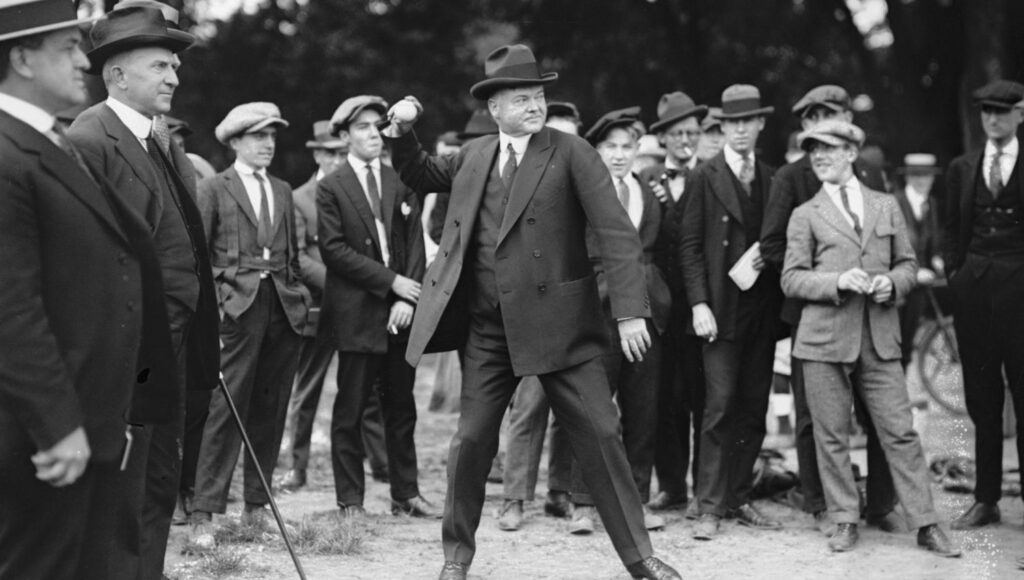
01. Hoover was the first president born west of the Mississippi River.
Herbert Clark Hoover, born on August 10, 1874, emerged into the world in a humble two-room cottage constructed by his father in West Branch, Iowa. This serene prairie settlement housed a mere 265 souls. Astonishingly, the young Hoover didn’t traverse beyond the Mississippi’s eastern banks until he reached the age of 22.
02. Hoover became an orphan at age 9.
At the tender age of 6, Hoover encountered the loss of his father due to a heart attack combined with pneumonia’s grip. This affliction struck once more just over three years later, when his mother, Hulda, succumbed to pneumonia and typhoid fever. This tragedy rendered young “Bertie,” alongside his elder brother and younger sister, bereft of parental care. As a consequence, the three siblings found themselves dispersed among various relatives. It was when Hoover was 11 that he embarked on a westward journey aboard a Union Pacific train, destined to reside with Hulda’s brother, John Minthorn, in Newburg, Oregon.
03. Hoover was a member of Stanford University’s inaugural class.
In the year 1891, Hoover embarked on his academic journey within the newly founded West Coast institution established by industrialist Leland Stanford. Though Hoover didn’t initially meet Stanford’s entrance criteria, the administering professor recognized his “remarkable keenness” and granted him conditional admission. Financial constraints compelled Hoover to reside within the construction workers’ quarters as they erected the university’s edifices. He even assumed the role of financial overseer for Stanford’s football and baseball teams, secured the position of treasurer, and it was within the domain of geology class that he would encounter his future wife, Lou Henry.
04. Hoover was a multi-millionaire.
“If a man hasn’t amassed a million dollars by the age of forty, he’s of limited value,” affirmed Hoover, who transitioned from humble beginnings to being a multi-millionaire on multiple occasions. Having earned a geology degree from Stanford in 1895, he commenced his career as an engineer at the British mining firm Bewick, Moreing, and Company. A globetrotter in pursuit of lucrative mineral deposits, by the age of 27, Hoover ascended to one of the firm’s four partners. Departing from the company in 1908, he swiftly garnered profitable ventures on nearly every continent barring Antarctica. Remarkably, he directed his presidential salary towards charitable causes.
05. Hoover helped save millions from starvation after two world wars.
While some decried Hoover’s response to the Great Depression’s plight, he garnered global recognition as a remarkable humanitarian, garnering five Nobel Peace Prize nominations. Spearheading an independent effort during World War I to repatriate 120,000 stranded American tourists from Europe, Hoover was subsequently engaged by the U.S. government to supply sustenance to Belgium, a neutral nation on the brink of famine with 7 million souls. His leadership extended to the American Relief Administration, delivering sustenance to millions across over 20 war-ravaged countries. Between 1921 and 1923, his aid efforts in the famine-ridden Soviet Union provided daily nourishment to more than 15 million. His resolute stance was, “Regardless of their politics, they shall not go hungry!” even in the face of opposition accusing him of aiding communism. Post-World War II, President Harry Truman entrusted the Republican Hoover with coordinating global famine-prevention endeavors, leading to his associate Neil MacNeil’s assertion that “He fed more people and saved more lives than any other man in history.”
06. Franklin D. Roosevelt once wished Hoover would become president.
Following Hoover’s commendable actions in World War I, he ascended as a prime candidate for both Republicans and Democrats in the 1920 presidential race. Franklin D. Roosevelt, then assistant secretary of the Navy, expressed his sentiment with, “He is truly exceptional, and I wish he could assume the role of President of the United States. There couldn’t be a better choice.” However, a dozen years later, these two figures became fierce rivals in the presidential arena, resulting in Roosevelt’s resounding victory over Hoover.
07. Before Hoover became president, he starred in the first television broadcast in American history.
While serving as commerce secretary under President Calvin Coolidge, Hoover’s voice and visage experienced a groundbreaking live transmission on April 7, 1927, marking America’s inaugural television demonstration. Hoover conveyed his message to an audience of journalists and dignitaries in New York City from a distance of 200 miles in Washington, D.C., proclaiming the triumph of “human genius” over the limitations of distance.
08. He won the presidency in his first-ever election campaign.
Remarkably, Hoover clinched the presidency in his debut electoral endeavor during the 1928 campaign. Until then, he had not held any elected office, his previous roles having been appointed positions within the government.
09. There is a sport that bears Hoover’s name.
To ensure Hoover’s physical well-being, White House physician Admiral Joel T. Boone devised a morning activity known as “Hooverball,” engaging the president and his staff. Played on the White House’s southern lawn, teams of two to four players volleyed a 6-pound medicine ball over an 8-foot-high net. Originating in 1931 and given its moniker by a New York Times journalist, this sport resembled tennis in its court structure and scoring. However, it emphasized quickness and vigor, providing a condensed yet invigorating workout. Hoover himself wrote in his memoirs that it required less finesse than tennis, resulting in a more spirited and brisk exercise. Today, an annual national Hooverball championship takes place in his birthplace of West Branch, Iowa.
10. He was not invited to the dedication of Hoover Dam.
The colossal dam, now known as Hoover Dam, was conceived during Hoover’s tenure as commerce secretary and was under construction during his presidency. Despite his significant contributions, Roosevelt’s Secretary of the Interior, Harold Ickes, contested Hoover’s involvement and thus christened the structure “Boulder Dam.” In a poignant twist, Hoover was not invited to the dam’s dedication by Roosevelt in 1935, who omitted any mention of his predecessor during the ceremony. Nevertheless, in 1947, President Harry Truman reinstated the original name, solidifying the enduring legacy of Hoover Dam.